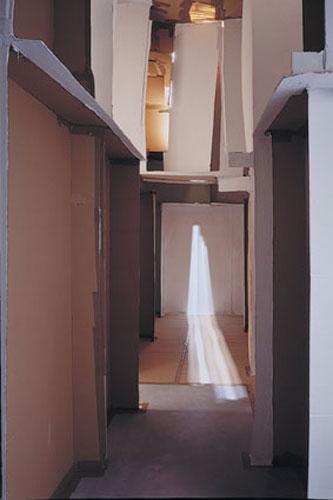Carlos Bunga
dal 12/4/2005 al 21/5/2005
Segnalato da
12/4/2005
Carlos Bunga
Galeria Elba Benitez, Madrid
The Elba BenÃtez Project 2005. Progressive transformation of the space

The Elba BenÃtez Project 2005.
Carlos Bunga (Oporto 1976) came to international attention when his work was
shown at Manifesta 5 in San Sebastián, Spain, in 2004.
His short career began in 2003 when, after finishing his degree at Escola
Superior de Arte e Design at Caldas da Rainha in Portugal, he won the Premio
EDP Novos Artistas, the most prestigious award for young artists in
Portugal. That same year, the artist exhibited one of his installations at
the Serralves Museum in Porto.
The exposure given to his work at Manifesta 5 brought with it the
opportunity to participate in numerous projects outside Portugal. Among them
is The Elba BenÃtez Project.
Bunga uses materials such as pressed cardboard, paints and wrapping tape to
build rooms that extrude like outgrowths stuck onto existing constructions
or architectures. Bunga’s construction process –which though carefully
planned leaves a number of choices to be made during the production stage–
is documented systematically and thoroughly by a photographer (Luis AsÃn
Studio for The Elba BenÃtez Project). The end result of his intervention on
the space reflects some stylistic affinities with Kurt Schwitters' Merzbau,
or Gordon Matta Clark’s work.
Carlos Bunga began work on the inner space of the GalerÃa Elba BenÃtez on
the 16th of March. The artist’s intervention, which lasted until Sunday 10th
of April, gradually transformed the entire layout of the gallery. Without
any assistance, he built a complex place of interlinking structures
supporting and holding each other together; a space into which the light
filtered dimly through chimneys or shafts running from the ceiling towards
the floor of, each one of them set at a different height. Time became
manifest in the space as its progressive transformation was documented by
the camera of the Luis AsÃn Studio.
This new place –a house within a house- invites the visitor to explore
associations with other familiar places, imagined or experienced previously.
The materials employed to build the temporary structures are designed to
blend together well with the original structures of the gallery’s rooms. For
the visitor, however, this fusion, giving rise to a new hybrid body, happens
quite imperceptibly.
The paint, applied at the final stage of the intervention, signals an end to
its spatial expansion. The act of painting heralds a conclusion.
From the caved-in ruins of the structure that was built up painstakingly
over weeks, a new place is reborn –the one that is now on display to
visitors– infused with paints, colours and light.
Carlos Bunga trained as a painter. His early works –oils on canvas- were
often installed on specially selected walls of the city where he lived as a
student. He would then document the effect that exposing the paintings to
the environment (climate, weather, pollution) had on them. Following this
experience he became more interested in the buildings themselves and in the
walls, the structures and the spaces surrounding those painting.
Before embarking upon The Elba BenÃtez Project, Carlos Bunga had an
exhibition at the alternative venue W139, in Amsterdam, in autumn 2004. His
upcoming projects for 2005 include participating at the Artists Space, in
collaboration with the Center for Curatorial Studies, Bard College NYC, in
the group show Things Fall Apart All Over Again. He also has been selected
to take part in Insite 05, San Diego in August. At the end of 2005 he will
have a solo exhibition at Culturgest, Porto.
Forthcoming exhibition: David Goldblatt. PHE05
Galeria Elba Benitez
San Lorenzo 11 28004 Madrid
Gallery opening times: Tuesday to Saturday from 11.00 to 14.00 and from 16.30 to 20.30.



